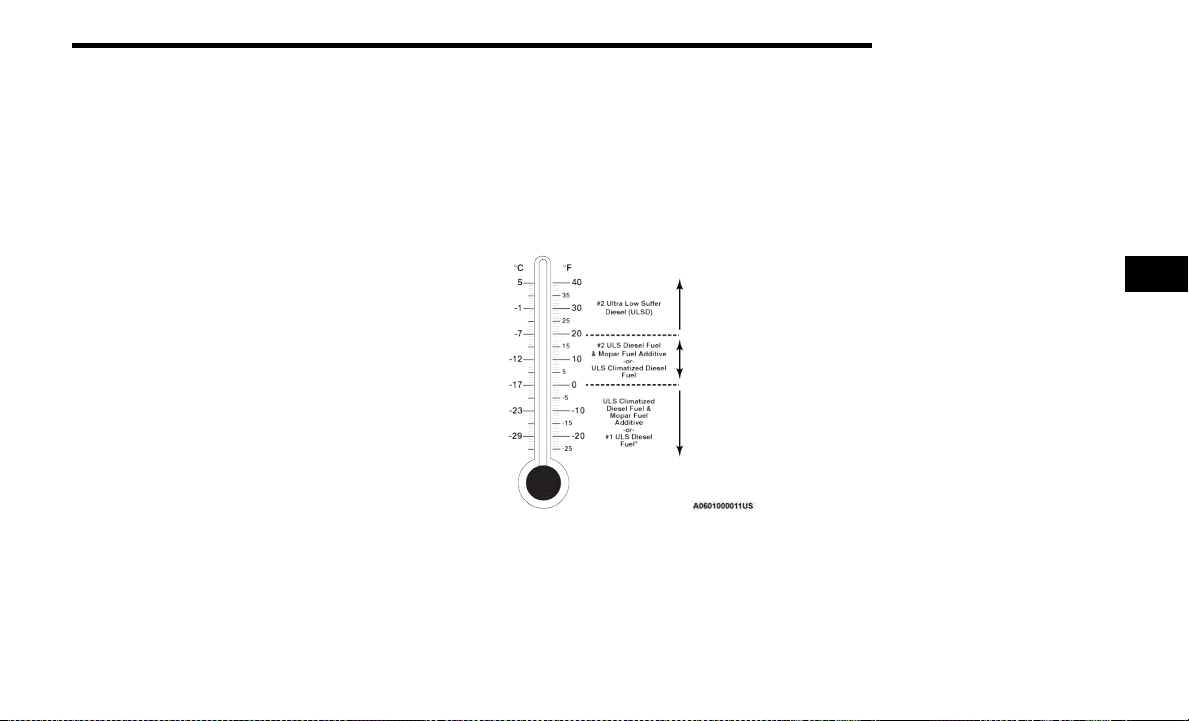Loading ...
Loading ...
Loading ...

STARTING AND OPERATING 135
NORMAL OPERATION — DIESEL ENGINE
Observe the following when the engine is
operating:
All message center lights are off.
Malfunction Indicator Light (MIL) is off.
Engine oil pressure is above 10 psi (69 kPa)
at idle.
Voltmeter operation:
The voltmeter may show a gauge fluctuation
at various engine temperatures. This cycling
operation is caused by the post-heat cycle of the
intake manifold heater system. The number of
cycles and the length of the cycling operation is
controlled by the engine control module. Post-heat
operation can run for several minutes, and then
the electrical system and voltmeter needle will
stabilize.
The cycling action will cause temporary dimming
of the headlamps, interior lamps, and also a
noticeable reduction in blower motor speed.
COLD WEATHER PRECAUTIONS
Operation in ambient temperature below
32°F (0°C) may require special considerations.
The following charts suggest these options:
Fuel Operating Range
NOTE:
Use Ultra Low Sulfur Diesel (ULSD) Fuels
ONLY.
Fuel Operating Range Chart
*Number 1 Ultra Low Sulfur Diesel Fuel should
only be used where extended arctic conditions
(0°F/-18°C) exist.
NOTE:
Use of Climatized Ultra Low Sulfur Diesel Fuel or
Number 1 Ultra Low Sulfur Diesel Fuel results in
a noticeable decrease in fuel economy.
Climatized Ultra Low Sulfur Diesel Fuel is a blend of
Number 2 Ultra Low Sulfur and Number 1 Ultra Low
Sulfur Diesel Fuels which reduces the temperature
at which wax crystals form in fuel.
The fuel grade should be clearly marked on the
pump at the fuel station.
The engine requires the use of Ultra Low Sulfur
Diesel Fuel. Use of incorrect fuel could result in
engine and exhaust system damage
Ú
page 443.
If Climatized or Diesel Number 1 ULSD fuel is
not available, and you are operating below
(20°F/-6°C), in sustained arctic conditions,
Mopar® Premium Diesel Fuel Treatment (or
equivalent) is recommended to avoid gelling
(see Fuel Operating Range Chart).
Under some circumstances increased engine noise
may be audible in the seconds following a cold start.
This is most likely to occur when using fuel that isn't
blended for the ambient temperature present. This
may occur on an unseasonably cold day or when a
truck is fueled in a warmer climate and driven to a
colder climate. The noise can typically be prevented
by using Mopar® Premium Diesel Fuel Treatment as
recommended (see Fuel Operating Range Chart).
4
22_DJD2_OM_EN_USC_t.book Page 135
Loading ...
Loading ...
Loading ...